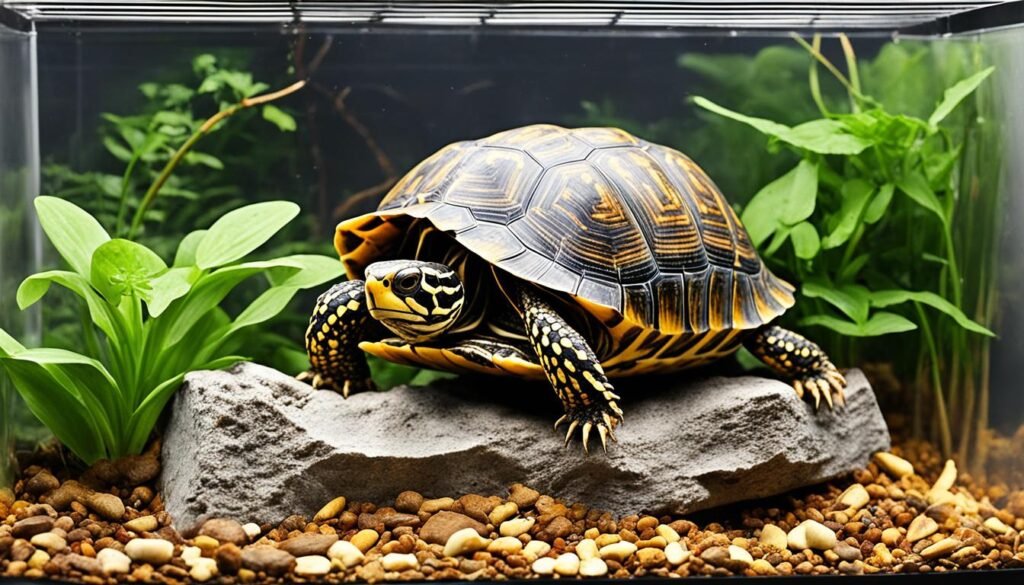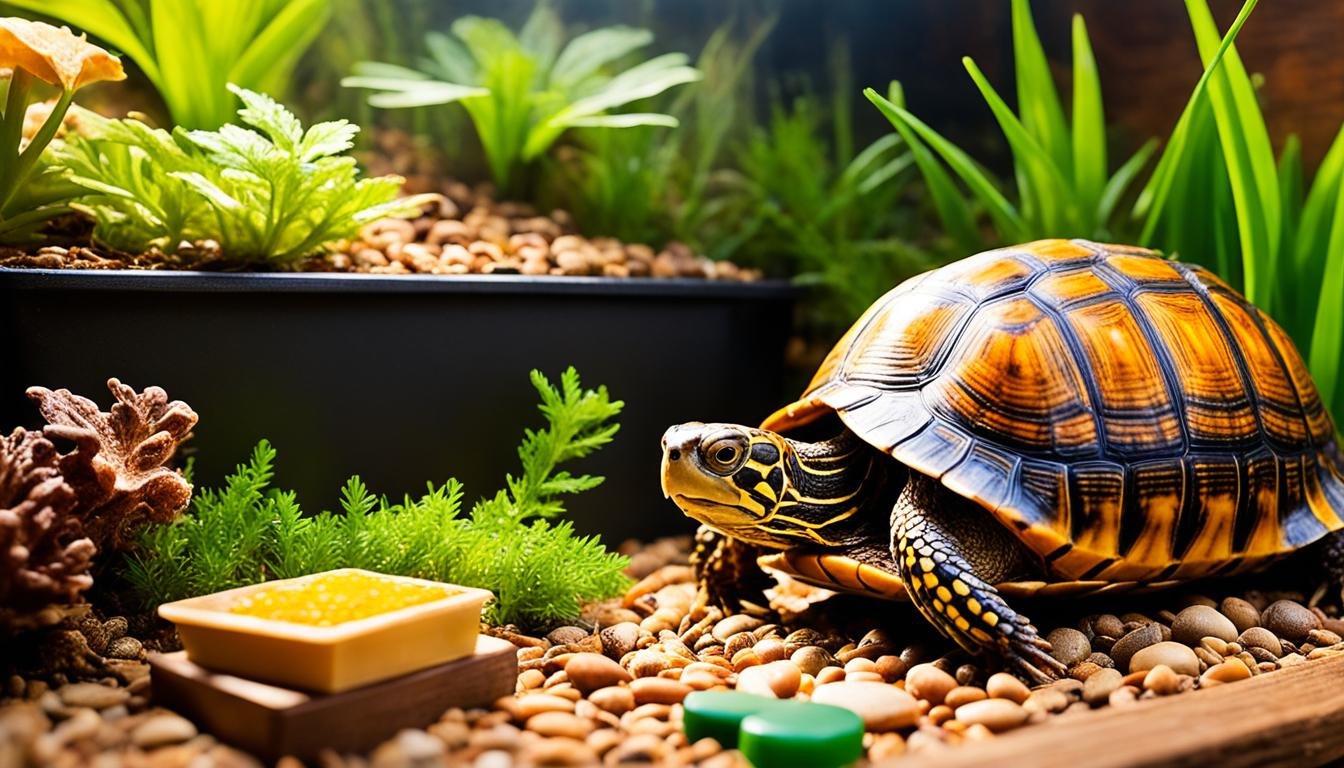Did you know that box turtles can live for several decades? These fascinating reptiles require a carefully maintained environment to thrive, making them a long-term commitment for pet owners. With different species of box turtles and specific housing and dietary needs, it’s important to understand how to provide the best care for these unique creatures. In this article, I will guide you through the essential aspects of box turtle care, including their habitat, diet, shell health, and more.
Key Takeaways:
- Box turtles are long-lived and require a lifetime of care and commitment.
- Understanding their specific habitat and dietary needs is crucial for their well-being.
- Maintaining proper shell health is essential for the overall health of box turtles.
- Regular veterinary check-ups are important to ensure their long-term well-being.
- Responsible acquisition from reputable breeders or rescue organizations is recommended.
Housing and Environment
Box turtles require a suitable habitat and environment to thrive. Whether you choose an outdoor pen or an indoor enclosure, it’s essential to provide the right conditions for their well-being.
Outdoor Pen
An outdoor pen is ideal for box turtles as it allows them to experience a natural environment. Here are the key features to consider:
- Walls: The pen should have walls at least 18 inches tall to prevent escape and keep them safe from predators.
- Sunny and Shady Areas: Design the pen with a mix of sunny and shady spots to mimic their natural habitat. This allows the turtles to regulate their body temperature.
- Hiding Places: Provide various hiding spots like logs or rocks where box turtles can retreat for security and privacy.
- Water Dish: Include a shallow water dish in the pen for drinking and soaking purposes. Ensure the dish is easily accessible and cleaned regularly.
In the outdoor pen, box turtles can enjoy basking under the sun, foraging for food, and exhibiting their natural behaviors.
Indoor Enclosure
If keeping box turtles indoors, a well-designed enclosure can provide a comfortable and safe environment. Consider the following:
- Terrarium or Large Tub: Use a terrarium or convert a large tub into an indoor housing for your box turtle. Ensure there is enough space for them to roam and explore.
- Heat Sources: Box turtles require a stable temperature range. Provide heat sources such as basking lamps or ceramic heat emitters to maintain the appropriate temperature gradient.
- UV Lighting: UVB lighting is crucial for box turtles to synthesize vitamin D3 and absorb calcium. Use a UVB lamp to provide the necessary light spectrum.
- Hiding Spots: Include hiding spots like artificial caves or half logs to create a sense of security and help box turtles feel at ease.
- Shallow Water Dish: Place a shallow water dish in the enclosure for drinking and soaking. Ensure the water is clean and changed daily.
Note that box turtles may hibernate if housed outdoors or if the enclosure temperature drops. However, their health should be assessed by a veterinarian before allowing hibernation.
Remember, creating a suitable housing and environment for your box turtle is essential for their overall well-being. Choose the option that suits your turtle’s needs and provides them with a comfortable and stimulating living space.
| Outdoor Pen | Indoor Enclosure |
|---|---|
| Walls at least 18 inches tall | Terrarium or large tub |
| Sunny and shady areas | Heat sources (basking lamps, ceramic heat emitters) |
| Hiding places | UV lighting (UVB lamp) |
| Shallow water dish | Hiding spots |
Temperature and UVB Lighting
Proper temperature and UVB lighting are crucial for the health and well-being of box turtles. These reptiles have specific temperature requirements that need to be met to ensure their optimal conditions.
During the day, box turtles thrive in temperatures ranging from 70 to 80 degrees Fahrenheit, with a basking spot temperature of 85 to 90 degrees Fahrenheit. At night, the temperatures can drop to 65 to 75 degrees Fahrenheit. It’s important to maintain these temperature ranges consistently.
To regulate the temperature in their enclosure, a heat source is necessary. A basking lamp or ceramic heat emitter can be used to provide the necessary warmth. These heat sources should be positioned in a way that allows the turtle to move closer or farther away from the heat to regulate its body temperature.
UVB lighting is another essential aspect of box turtle care. UVB light helps the turtle metabolize calcium and prevent a condition called metabolic bone disease, which can lead to weakened bones and other health issues.
Box turtles should receive 12 hours of UVB lighting every day. This can be achieved through natural sunlight or by using a UVB lamp specifically designed for reptiles. The UVB lamp should be placed in a location that provides adequate exposure to the turtle, ensuring it receives the necessary ultraviolet rays.
To summarize:
- Daytime temperature: 70-80°F
- Basking spot temperature: 85-90°F
- Nighttime temperature: 65-75°F
- Heat source: basking lamp or ceramic heat emitter
- UVB lighting: 12 hours per day through natural sunlight or UVB lamp
By maintaining the proper temperature and providing adequate UVB lighting, you can create a suitable environment for your box turtle, promoting its overall health and well-being.
| Temperature: | Requirement: |
|---|---|
| Daytime Temperature | 70-80°F |
| Basking Spot Temperature | 85-90°F |
| Nighttime Temperature | 65-75°F |
Humidity and Substrate
Proper humidity levels are essential for the health and well-being of box turtles. These reptiles thrive in an environment with a humidity level of around 60%. Maintaining the appropriate humidity can be achieved through daily misting and providing a suitable substrate that retains moisture.
When it comes to choosing the right substrate, box turtles prefer natural options that mimic their natural habitat. Chemical-free topsoil, leaves, and moss make excellent choices. These materials not only help to retain moisture but also create a soft and comfortable surface for the turtles to explore and burrow.
It is important to layer the substrate at least 4 inches deep to allow for proper burrowing. This depth ensures that box turtles can engage in their natural behaviors while also providing them with a sense of security and privacy.
| Humidity: | Around 60% |
|---|---|
| Substrate Options: | Chemical-free topsoil, leaves, moss |
| Substrate Depth: | At least 4 inches |
Diet and Feeding
Proper nutrition is essential for the health and well-being of your box turtle. As omnivores, they require a varied diet to meet their nutritional needs. This includes a combination of fresh vegetables, fruits, insects, low-fat meats, and even pinky mice.
While there are commercial turtle diets available, it is important to supplement them with fresh foods to ensure a balanced diet. Fresh foods provide important vitamins and nutrients that may be lacking in commercial options.
If you choose to feed your box turtle fresh foods, it’s recommended to provide a variety of leafy greens, such as kale, collard greens, and dandelion greens. They can also enjoy fruits like berries, melons, and apples in moderation. Insects, such as crickets and mealworms, can be offered as a source of protein.
Young box turtles should be fed daily, while adults can be fed every other day. It’s important to monitor their weight and adjust their feeding schedule accordingly to prevent overfeeding or malnutrition.
Feeding Tips:
- Place the food on a shallow dish or feeding platform to prevent the ingestion of substrate.
- Ensure clean water is available at all times in a shallow dish for drinking and soaking.
Box turtles are known to be messy eaters, so it’s important to clean their enclosure regularly to maintain hygiene and prevent the growth of bacteria.
By providing a balanced and varied diet, you can ensure that your box turtle receives the necessary nutrients for optimal health and longevity.
Common Health Issues
Box turtles are known to be susceptible to various health issues that require proper care and attention. The most common health problems include:
Metabolic Bone Disease (MBD)
Metabolic bone disease in box turtles is often caused by a lack of UVB exposure, resulting in calcium and vitamin D deficiencies. This condition weakens the turtle’s bones over time and can lead to deformities, fractures, and even death if left untreated.
Respiratory Infections
Respiratory infections are frequent in box turtles, usually due to inadequate humidity or low temperatures in their enclosure. Symptoms of respiratory infections include wheezing, mucus discharge from the nostrils, lethargy, and loss of appetite. Prompt veterinary intervention is necessary to prevent complications.
Shell Rot
Shell rot is a common concern in box turtles and occurs due to bacterial or fungal infections. If left untreated, shell rot can cause the shell to become cracked, dry, and emit an unpleasant odor. Regular inspection of the turtle’s shell is crucial to detect early signs of infection and seek appropriate treatment.
Parasitic Infections
Box turtles can also suffer from parasitic infections, including internal and external parasites. These parasites can cause various health issues, such as digestive problems, weight loss, and weakness. A veterinarian specializing in reptiles should diagnose and treat these infections properly.
To maintain the well-being of your box turtle, it is essential to provide appropriate care, regular veterinary check-ups, and prompt treatment for any health concerns. Seeking professional advice from a reptile veterinarian is crucial for accurate diagnosis and tailored treatment plans.
Selecting a Pet Turtle

Box turtles are declining in the wild and keeping them as pets requires careful consideration and responsible acquisition. It is highly recommended to choose a captive-bred pet turtle from a reputable breeder or a rescue organization. By doing so, you ensure that the turtle has been raised in captivity and is better adapted to living in an enclosure. Additionally, acquiring a turtle from a reputable source allows you to obtain information about the turtle’s background, including any potential health issues. A captive-bred pet turtle is a great choice for those who want to provide a loving home while supporting conservation efforts.
Venturing Into the Box Turtle World
Before embarking on your journey to become a box turtle owner, it’s essential to familiarize yourself with reputable breeders and trustworthy rescue organizations. Conduct thorough research to find established breeders who prioritize the health and well-being of their turtles. Consider reaching out to local reptile clubs or organizations for recommendations. The turtle community is often supportive and can provide valuable insights into reputable breeders and rescue groups in your area.
Engaging with a reputable breeder or rescue organization has several advantages:
- You have access to details about the turtle’s lineage, which can help in understanding potential genetic health issues.
- Reputable breeders prioritize the turtles’ well-being and provide them with proper care and nutrition from an early age.
- Rescuing a turtle from a reputable organization helps provide a second chance for those in need.
- Rescue organizations often perform health checks and provide necessary medical treatment.
When selecting a pet turtle, it’s important to perform a thorough health check to ensure you are bringing home a healthy companion. Look for signs of bumps, redness, mucus, cloudy eyes, or a firm shell, all of which could indicate potential health issues.
Avoiding the Wild Capture of Box Turtles
In many states, it is illegal to keep wild box turtles as pets due to their declining populations. Capturing wild box turtles can disrupt ecosystems and threaten their survival in the wild. By acquiring a turtle from a reputable breeder or rescue organization, you contribute to conservation efforts and help protect these beautiful creatures in their natural habitats.
Outdoor Housing Considerations
When it comes to providing a suitable habitat for box turtles, outdoor enclosures are preferred. They not only allow for constant exposure to sunlight but also enable the turtles to engage in natural behaviors. To ensure the safety and well-being of your box turtle in an outdoor environment, consider the following:
1. Secure Enclosure
Construct an outdoor enclosure with solid walls that extend at least a foot underground to prevent the turtles from digging their way out. This will also deter potential predators from gaining access to the enclosure. Use wire mesh to cover the top of the enclosure, allowing sunlight to penetrate while keeping unwanted visitors at bay.
2. Sunlight Exposure
Box turtles thrive in sunlight, which is crucial for their metabolism and overall health. Position the outdoor enclosure in an area that receives ample sunshine throughout the day. This ensures that your turtle can bask and absorb essential UV rays.
3. Temperature Control
While box turtles can tolerate a range of temperatures, it’s important to provide temperature control within the enclosure. Ensure that the enclosure has shaded areas and hiding spots where the turtle can retreat to if it gets too hot. Additionally, factor in the local climate and make adjustments accordingly to create a suitable environment for your turtle.
4. Sheltered Areas
Creating sheltered areas within the enclosure is essential for box turtles to feel secure. This can be achieved by incorporating plants, rocks, or driftwood to provide hiding spots and natural cover. These protected areas allow the turtle to retreat and rest, promoting their natural behaviors.
In summary, an outdoor enclosure with adequate sunlight, temperature control, and secure features provides the ideal environment for your box turtle to thrive and lead a healthy life.
Indoor Housing Considerations

If you choose to keep your box turtles indoors, it’s essential to create a suitable and comfortable environment for them. A spacious indoor enclosure will provide them with the necessary space to roam and explore. To ensure their well-being, consider the following aspects:
Create the Perfect Indoor Enclosure
Start by selecting an enclosure that is large enough to accommodate your box turtles comfortably. A minimum size of 36 inches long, 12 inches wide, and 12 inches tall is recommended for a single adult box turtle. Provide adequate hiding spots using rocks, logs, or commercial turtle hides for privacy and security.
| Aspect | Recommendation |
|---|---|
| Enclosure Size | A minimum of 36 inches (L) x 12 inches (W) x 12 inches (H) for a single adult box turtle. |
| Hiding Spots | Include rocks, logs, or commercial turtle hides for privacy and security. |
Temperature Control and Lighting
Temperature control is crucial for maintaining a suitable indoor habitat for box turtles. Use heat lamps or heat pads to create a basking spot with a temperature range of 85 to 90 degrees Fahrenheit. The overall enclosure temperature should be kept between 70 and 80 degrees Fahrenheit during the day and can drop to 65 to 75 degrees Fahrenheit at night.
Additionally, box turtles require UVB lighting to metabolize calcium and prevent metabolic bone disease. Provide them with 12 hours of UVB lighting per day using a UVB lamp suitable for reptiles.
| Aspect | Recommendation |
|---|---|
| Temperature | Maintain a basking spot at 85-90°F and an overall enclosure temperature of 70-80°F during the day. |
| UVB Lighting | Provide 12 hours of UVB lighting per day using a suitable UVB lamp for reptiles. |
Enhance the Habitat with Live Plants
Consider adding live plants to the indoor enclosure to create a more natural and stimulating environment for your box turtles. Live plants can provide additional hiding spots, promote air quality, and create a visually pleasing enclosure.
When selecting live plants, ensure they are non-toxic and safe for box turtles. Some suitable options include pothos, spider plants, and snake plants. Place the plants strategically to provide both hiding spots and visual appeal.
| Aspect | Recommendation |
|---|---|
| Live Plants | Include non-toxic plants like pothos, spider plants, and snake plants to enhance the habitat. |
Creating an appropriate indoor habitat for your box turtles will help ensure their overall well-being and happiness. Providing ample space, temperature control, proper lighting, hiding spots, and live plants will contribute to a comfortable and stimulating living environment.
Water and Soaking
Box turtles require proper hydration to ensure their overall health and well-being. Providing them with access to a shallow water dish is essential for drinking and soaking. This allows them to stay hydrated and regulate their body temperature effectively.
To create a suitable water dish, use a shallow container that allows easy access for the turtle. The dish should be cleaned and filled with fresh water daily to maintain cleanliness and prevent the growth of harmful bacteria. It is important to note that box turtles may defecate in their water dish, so regular cleaning is necessary.
When placing the water dish in the enclosure, consider surrounding it with moss or stones to create a more natural environment. This mimics the turtle’s natural habitat and provides a sense of security. Multiple water dishes are recommended, especially if you have multiple hatchlings, as it ensures easy access for all turtles.
Soaking is an essential behavior for box turtles as it not only aids in hydration but also helps with shedding. By providing a shallow water dish, you enable the turtle to soak and soften its skin, making shedding easier and less uncomfortable for them.
Importance of Hydration:
- Prevents dehydration and associated health issues
- Aids in digestion and metabolism
- Facilitates shedding of old skin
- Helps maintain proper body temperature
Hideouts and Plant Decorations
Creating a comfortable and stimulating environment for your box turtle is essential to their well-being. Providing hideouts and incorporating plant decorations in their enclosure can promote privacy, security, and a more natural habitat immersion.
Hideouts
Box turtles appreciate hideouts where they can retreat and feel safe. Here are some great hideout options for your box turtle:
- Half logs: These naturalistic hideouts mimic fallen logs in the wild. They provide a secure and enclosed space for your box turtle to rest and hide.
- Clay pots: Turned upside down, clay pots make excellent hideouts for box turtles. They offer a dark and cozy space for your turtle to relax and feel secure.
- Reptile caves: Designed specifically for reptiles, these hideouts come in various sizes and shapes. They create a secluded space where your box turtle can retreat and have a sense of privacy.
Placing hideouts in different areas of the enclosure allows your box turtle to choose their preferred hiding spot based on temperature, light conditions, or their mood.
Plant Decorations
Introducing plants to your box turtle’s habitat not only adds visual appeal but also provides naturalistic hiding places and enrichment opportunities. Here are some options to consider for plant decorations:
- Live plants: Adding live plants like pothos, spider plants, or bromeliads not only enhances the aesthetics of the enclosure but also offers your turtle a natural hiding place. Live plants can also help maintain humidity levels in the enclosure.
- Silk or plastic plants: If maintaining live plants is challenging, silk or plastic plants can be a suitable alternative. They provide visual barriers and give your box turtle various points of cover.
When selecting plants, ensure they are non-toxic and safe for your box turtle species. Avoid using plants that have been treated with pesticides or chemicals.
Remember to arrange the plants strategically, allowing your box turtle to navigate through the enclosure and use them as shelter.
| Benefits of Hideouts and Plant Decorations for Box Turtles | Description |
|---|---|
| 1. Privacy and security | Hideouts provide a sense of privacy and security for box turtles, reducing stress and promoting natural behaviors. |
| 2. Enrichment and mental stimulation | Hideouts and plant decorations offer enrichment opportunities, encouraging exploration, foraging, and exercise, which are vital for a healthy box turtle. |
| 3. Aesthetically pleasing enclosure | The addition of hideouts and plants creates a visually appealing habitat that closely resembles a box turtle’s natural environment. |
| 4. Environmental humidity regulation | Certain live plants can help maintain proper humidity levels in the enclosure, ensuring the respiratory health of your box turtle. |
Conclusion
Providing optimal care for box turtles requires a careful and long-term commitment. By understanding and meeting their housing, temperature, humidity, diet, and healthcare needs, we can ensure their well-being as healthy pets.
Acquiring box turtles responsibly is vital. Choose captive-bred turtles from reputable breeders or rescue organizations to ensure their history and health are known, as well as their adaptability to captivity. Before adopting, perform thorough health checks to identify any signs of concern such as bumps, redness, mucus, cloudy eyes, or a firm shell.
Proper enclosure setup plays a crucial role in maintaining the health of box turtles. Whether keeping them indoors or outdoors, ensure the temperature is regulated, providing basking spots and UVB lighting. Humidity levels should be maintained, and turtles should have access to clean water for drinking and soaking.
Routine veterinary check-ups for box turtles are essential for preventive care and early detection of any health issues. Consulting with a veterinarian specializing in reptiles will help ensure the longevity and well-being of these fascinating creatures.


5 thoughts on “Box Turtle Care Guide: Tips for Healthy Pets”